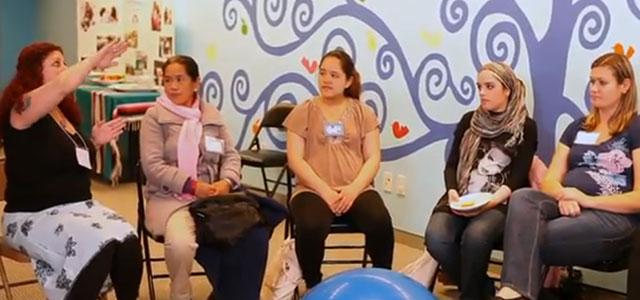
A CenteringPregnancy session at San Francisco General Hospital
CenteringPregnancy Offers a Group Model for Prenatal Care to Empower and Engage Women
“Most pregnant women are hungry for community and want to be around other women going through the same life-changing experience,” says Margy Hutchison, certified nurse-midwife (CNM), clinical professor in the Department of Obstetrics, Gynecology and Reproductive Sciences at the UC San Francisco School of Medicine and director of the CenteringPregnancy programs at San Francisco General Hospital (SFGH). CenteringPregnancy, offered across UCSF maternity care services, is an alternative to the traditional individual model of pregnancy care and is designed to build community by taking women out of the exam room and putting them into group spaces for their prenatal care and education.
Pioneered in the early 1990s by Yale-trained CNM Sharon Schindler Rising, CenteringPregnancy was conceived as a way to improve outcomes by increasing access to prenatal education and community and empowering women to take an active role in their prenatal care. Rising developed the CenteringPregnancy model based on a body of research suggesting that prenatal education and social support had significant benefits, including reduced risk of having a baby with low birth weight and less substance abuse, among at-risk mothers.
Moving into a Group Space for Prenatal Care
Low- and moderate-risk pregnant women at SFGH or the UC San Francisco Medical Center can opt for Centering or for the traditional individual model of care. After an initial individual health assessment with a midwife or obstetrician, women who choose the Centering model of care come together in groups of 8 to 12, formed around their estimated due dates, for 10 prenatal sessions that include self-care (usually recording vital signs and weight and checking the urine for blood, sugar or protein), health assessment by a midwife or physician, and facilitated discussions of topics of importance to the group. These can range from managing symptoms at a particular stage of pregnancy to preparing a sibling for the arrival of a new baby, and beyond.
CenteringPregnancy at UCSF
The Centering program at UCSF was started by midwives at SFGH in 1999 as a way of improving prenatal education and increasing patients’ engagement in the process of pregnancy and preparing for childbirth and parenthood. Now, about half of women who have midwifery care at SFGH opt to participate in Centering. It can be especially valuable for the underserved populations served by SFGH, where it can enhance culturally sensitive care and give a sense of empowerment to vulnerable women. Says Hutchison, “We have women who don’t speak English or with literacy problems who learn how to take their own blood pressures and record them accurately in their charts. I think it helps them feel better about themselves, and more prepared to be mothers.”
The group model can also help address issues that go beyond pregnancy and birth, both by reducing isolation and by providing additional information about services available in the community. SFGH’s Centering program partners with San Francisco’s Homeless Prenatal Program to bring prenatal care outside the clinic to a community-based organization that can offer additional support to low-income families at the same time they are preparing for the birth of a child.
Expanding CenteringPregnancy Beyond Low-Income and Lower-Risk Women
CenteringPregnancy doesn’t appeal only to underserved families, however. The combined obstetric and midwifery practice at the UC San Francisco Medical Center began offering it in 2007, and Suzanne Seger, CNM, associate professor in the Division of Maternal-Fetal Medicine, says that it appeals to women across socioeconomic backgrounds. Moreover, the Centering program is expanding to accommodate women who might not have been candidates for it in the past. “When we first thought of Centering, we thought it would only be for low-risk women, and yet we’ve seen higher-risk women fit in well,” Seger says, and UCSF midwives are looking to expand CenteringPregnancy in the future to offer it to a growing population of women with conditions like diabetes and obesity, which can add significant risks to pregnancy and birth.
Although it was started by midwives, the CenteringPregnancy model – and the benefits it can offer patients – is starting to interest physicians as well. While midwifery students at UCSF have been trained in CenteringPregnancy since the program’s inception at SFGH, Seger and her colleague Sharon Wiener (who founded the CenteringPregnancy program at UCSF Medical Center) began training medical residents in the Centering model five years ago, and it’s now part of the interprofessional education program for graduate midwifery and medical students and medical residents. “We’re now training about half the [obstetric] resident class, and we have requests from residents to continue Centering in their advanced training,” says Seger.
The reason for the growing interest is simple: CenteringPregnancy has been shown to improve both patient satisfaction and some health outcomes, such as decreased preterm birth and low birth weight, and increased breastfeeding initiation and duration. In the end, though, it’s about making women feel empowered throughout their pregnancies and beyond. Says Hutchison, “We want to help people feel that they’re making a difference in their own lives and in the lives of their families.”



